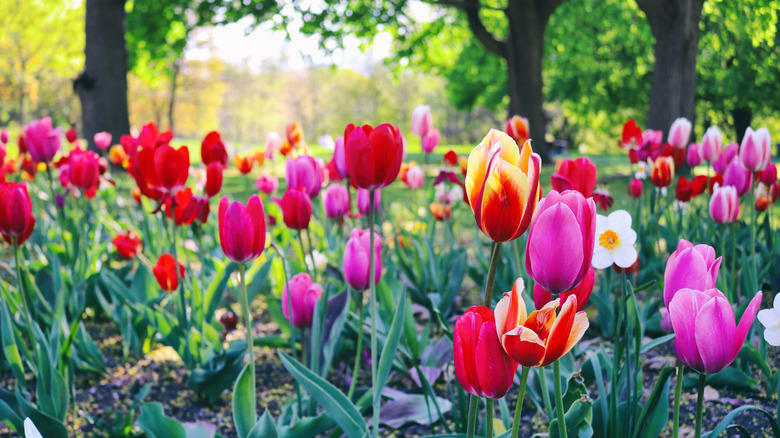The Best Time Of Year To Plant Tulips (& How Long Their Blooms Typically Last)
The tulip reigns supreme as the ultimate harbinger of spring. You awaken one late winter day expecting to gaze once again upon a frozen terrain, but you spy a leafy hint of green. Could it be? A sign of hope for warmer and more colorful days to come!
To achieve this late winter miracle, you'll need to plan ahead. If the best time to plant a tree is 20 years ago, then the best time to plant a tulip bulb is usually about four to five months before this fateful day. However, exactly when to purchase and plant your tulip bulbs can vary substantially depending on your climate zone. If you don't know what your USDA plant hardiness zone is, you can identify it with your zip code via the helpful 2023 USDA Plant Hardiness Zone Map. Once you have this piece of information, you can double-check it with your bulb supplier to know exactly when to plant.
In northern climes, this is typically in September or October, or when there's a certain pumpkin-spiciness in the air. However, if you live farther south, you can plant bulbs much later and sometimes even all the way up to winter as long as the soil is still soft enough. According to the Old Farmer's Almanac, all of these guidelines roughly translate to six to eight weeks before the ground freezes or when temperatures dip into the 40s at night. Again, these are general guidelines and your climate zone will more specifically dictate the best planting time.
How long will my tulip blooms last?
Fast forward four or five months from planting day. The birds are chirping and spring is finally in the air. Today is the day you spy those green leaves in an otherwise drab landscape. It feels impossible that the solid puck you plunked in the ground all those months ago is now bursting forth with color right before your eyes, but the bulb — defined as such by its underground storage structure — has reserved nutrients and specialized plant parts all those months to make this dramatic appearance.
Now that they're on full display, you want your tulips to last as long as possible. However, the average length of bloom time is very fleeting, at only about one to two weeks. Even that range will depend on many factors including temperature, moisture, and soil conditions. If the temperature is very warm, your tulips won't last as long unless they're partially shaded or protected from that heat by mulch. If you're not getting adequate rainfall, you should plan to water your tulips once a week. Another consideration is protecting your tulips from insect infestations such as snails or aphids. Additionally, curious animals such as rabbits, deer, or squirrels will need to be kept away from this colorful food source. All of these measures can help your tulips bloom for as long as possible.
Tips on planting tulips (and how often to do it)
Although tulips and other bulb plants are considered perennials, the bulbs weaken over time and can't be expected to come back year after year. At most, you can expect a lifespan of five years out of a tulip bulb, though there are some tricks to get them to bloom again.
However, it's advised to buy new bulbs each fall to ensure you get reliable blooms the following spring. If you're going to make this an annual ritual, the process on how to grow tulips from bulbs is pretty straightforward. First dig a hole or a long trough about five to eight inches deep (or roughly three times the height of the bulb). Place the bulb in the soil with the round side down and the pointy end facing up. Space each bulb at least five inches apart and cover completely with dirt. Then, simply water once and wait. Take this extra step to make sure that, come spring, you'll be greeted into the new season with the bright colors you are hoping for.


